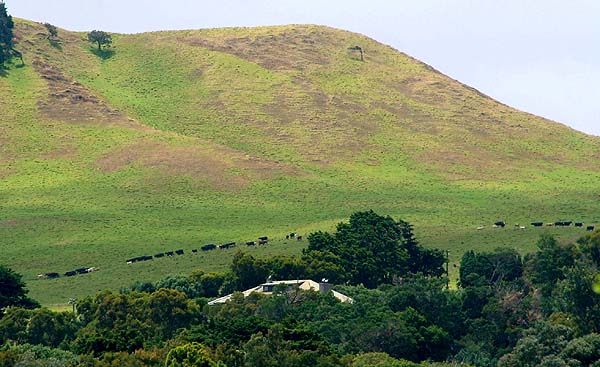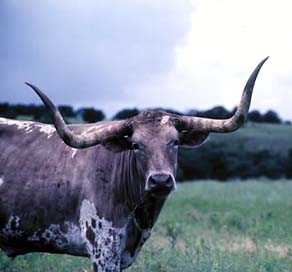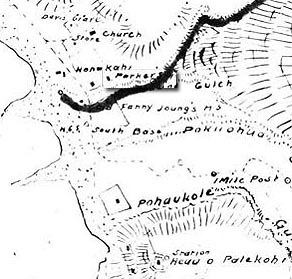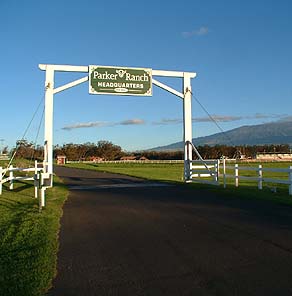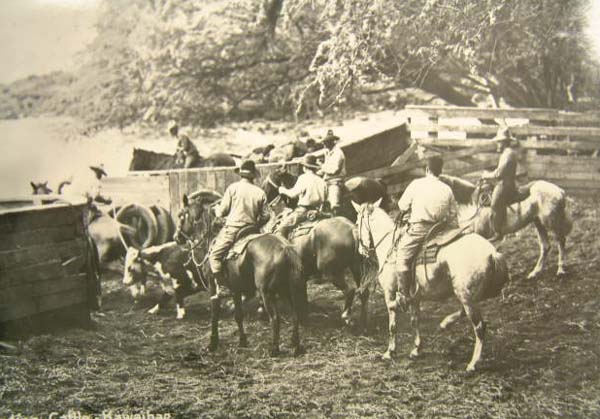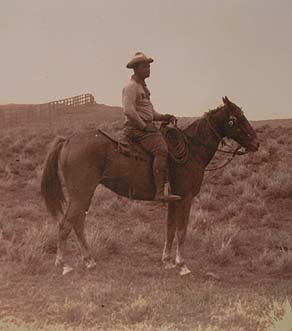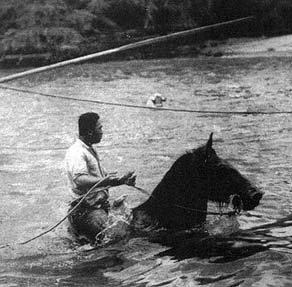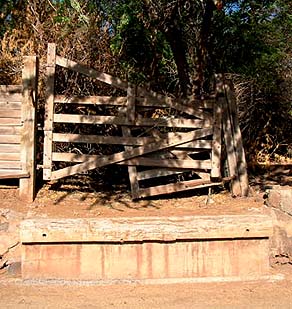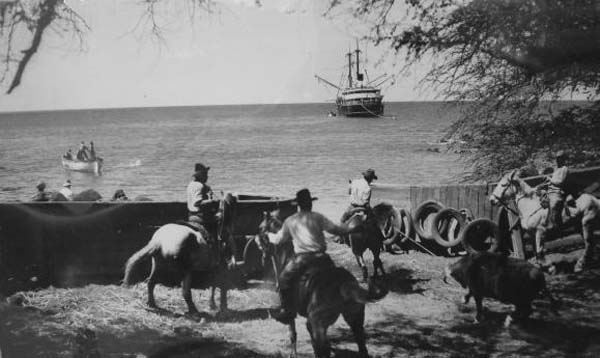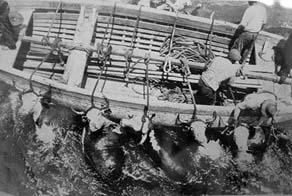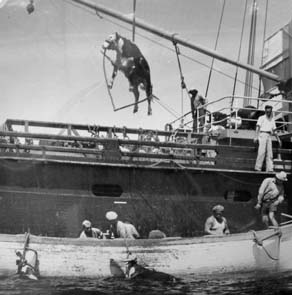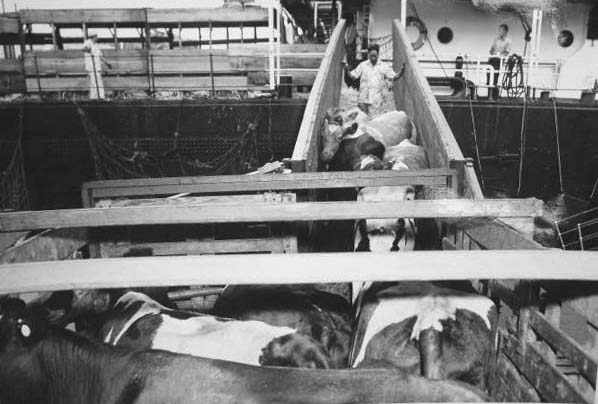 |
 |
 |
|||||
|
|
|||||||
|
|
|||||||
| |
|
|
|
"After the large canoes had delivered their acceptable cargoes," wrote Captain George Vancouver of his second visit to Kealakekua Bay, "they received and took to shore the live cattle, which I had been more successful in bringing from New Albion than on the former occasion. These consisted of a young bull nearly full grown, two fine cows, and two very fine bull calves, all in high condition....and as those I brought last year had thrived exceedingly well...I had little doubt, by this second importation, of having at length effected the very desirable object of establishing in this island a breed of those valuable animals" (Vancouver, 1798 III: 11). Following Vancouver's advice, Kamehameha placed a kapu on the cattle, and very quickly they were overrunning the islands, destroying the forests and native vegetation.
|
||
|
|
||
“Vancouver’s off-loading of those animals speaks to that human inclination to, as soon as is possible, export those species with which we are the most familiar and cause them to be naturalized in a new environment,” Hannah suggests. “So the trade goods became those familiar to the Anglos and the Europeans and the Americans that were coming through Hawai‘i. Pork and fowl and dog gave way to the goats and the sheep and the cattle. “And these animals wreaked a change across the landscape that no amount of discussion of what the rats that the Polynesians brought can compare. The subsequent introduced animals, I think, just eclipse those earlier ones and their harmful effect on the native eco systems.”
|
|
|
That’s when John Palmer Parker was hired to help take care of this problem. “John Palmer Parker arrived in Hawai‘i on a ship about 1812,” Billy says, recounting the story of the founder of the famous Parker Ranch. “Then he went on one trip, I think to Canton, China and back, and then he stayed back here. He was on a ship that traded sandalwood. "Then he married Princess Kipikane, a princesses from the court of King Kamehameha. He was able to get a homestead up in the Mana area, because of his connection to the royalty and friendship with the King in the beginning. And he got hired by King Kamehameha to get rid of the wild cattle that were becoming a problem.”
|
|
|
|
|
| “So Parker got established, and came in as a bullock hunter. He was a good marksman, good hunter. They would kill these wild beasts and the meat would be salted. They supplied the whaling vessels that came in with meat. And they also would load up on sweet potatoes and other crops that were raised. This is going out of Kawaihae. “Hawai‘i was trading meat, animal products, hides and other things, shipping to South America and back to continental United States, before the Western states were really into the business. As early as that. But our main thing in the beginning was getting rid of those wild beasts, and supplying the visiting ships with salt meats and other things for them to take back. “The hides were the big thing in shipping in those days. The price of meat was not too high. But hides and tallow played an important part then. About half-way up from Kawaihae, if you look at old aerial photos, you’ll see a lot of stone pens and everything, and that is where they did all of that work."
|
||
|
|
||
“Then Parker was enterprising. He was able to get more land, and that was the start of Parker Ranch. He was a stern person. Didn’t believe in drinking or anything like that. He was a churchman. Parker Ranch really made Waimea. It grew after the headquarters was moved down from the Mana area to below. And of course, the churches were there. “Parker Ranch started out with wild cattle in the beginning, then as the turn of the century came, better blood was brought in. But what really made Parker Ranch was Alfred W. Carter. He became the trustee in the early 1900s, I forget the exact date. The ranch, Thelma Parker’s had shares and then Sam Parker had half of it."
|
|
|
"Sam loved the fancy life and he would entertain King Kalakaua when he came to Waimea, and Sam wanted money. So he sold his share out for $600,000 of gold, so he could go on and continue living this fancy livelihood. And A.W. Carter got that for Thelma’s interest. “But A.W. ran that place like it was his own. And he did not really benefit by it. He was honest. He was a lawyer by profession but he brought in good cattle. He had the finest hereford cattle, I think, between my grandfather Hind at Pu‘u Anahulu and A.W. Carter up in Makahala, where the purebred station was. They had the finest Herefords in the state. They provided seed stock for many ranchers here.”
|
|
|
|
|
"They’d bring the cattle down Wednesday and then Saturday,” Lani recalls. “They would drive the cattle down from Waimea to Kawaihae, but they couldn’t do it in one day, so half way they would have a paddock where they would keep all the cows. They would stay overnight there and then early in the morning they would drive them down, past our home and go straight to the pier."
|
||
|
|
||
"And early in the morning we could hear them coming down the road. We would get up early in the morning watching the cows go by, and we’d go down to the pier and watch them hoisting them up." “I remember they would come down like about 3:30 or 4:00 in the morning,” says Jeannine, “and my Mom would say, ‘they’re bringing the cows down, they’re bringing the cows!’ And it was like a cattle drive. They would bring them up from Waimea, bring them all the way down, because they were going to put them on boats and take them to be slaughtered over on O‘ahu. "The house that we were living in had three sections that, if I remember correctly, were all screened in—no glass. And we had pune‘e. A pune‘e is what we would know today as a 'day bed.' My Mom had pune‘e, my Grandma had pune‘e and we would sit up on the pune‘e. There was a little ledge on the window sill, and my brother and I, we’d watch."
|
|
|
"Tutu Alec, who was my Grandma’s brother, he was one of the supervisors with the ranch, and we’d be hollering ‘Tutu Papa! Tutu Papa!’ and he’d make sure that he’d see us wave at him. And they’d go right through the little village and on down to the harbor.” "It was a big event, when the cattle came down," Lani says. " Everybody went by the stone wall to watch all the cows passing by. And they went down to watch them hoisting up the cows.” “Uncle John Kaimakini was a cowboy," ‘Ilima says. "It used to be at Kahua Ranch that every employee would get so many pounds of beef every Friday. So what we would do, my Dad would fish down Kawaihae, take the fish up to the ranch and they would bring meat home. Since we had no refrigeration, we’d salt the beef. We ate a lot of salt meats. My Mom would salt it."
|
"And of course the day we brought it home, my Mom would cook a big pot of stew and we would pulehu some—put it on the charcoal—and then the rest we would salt. And of course we would call the neighbors to come over." “We didn’t even fry it,” Lani adds, “we’d go and put a charcoal stove on it, and turn it on the charcoal. It was good. Later when we went to the beach, camping, I would buy a few steaks and I would throw them on the charcoal. You have a metal grill on top of the fire. You didn’t throw it right on the coals. We had a metal thing on there and then we would barbecue all the beef. “But those days we didn’t know how to make Japanese barbecue. Just threw it on the fire and Hawaiians used to call it pulehu meat. Pulehu means to throw on the coals, Hawaiian barbecue. And we had that with poi. We never knew what rice was. We always ate poi.”
|
|
|
|
|
|
“The steamer would come from Honolulu and to pick them up,” Lani continues. “They would drive cattle to the boat and then they would take six cows, I don’t know how but they attached them by the neck so they hang on to the boat, and they would take them out to the big steamer, and then they could load them up on the steamer, one cow at a time. Take it to Honolulu and slaughter it over there." "It was quite a day, boat day, when the ship came in,” Billy says fondly. “Those tramp ships would carry freight and cattle. Maybe about two hundred-twenty head of cattle aboard ship. It had long, open decks which they divided up in pens, sections. The lifeboats would be set with a beam down the middle which they could lash the animal to."
|
||
|
|
||
"The cowboy would rope the animal and lead it into the water with the horse. We’d have a knot so the noose could only tighten so far—enough to be secure but not to choke them. And we’d pull them into the water. “Usually you’d have a hazer, another animal that would be running alongside of the horses. We used two little dogs on either side of the gate. We came out of the pen, they’d nip the animal so it would jump into the water. Rope them with kaulas [ropes], put them in the water, and give the rope to the helmsmen on the life boat. "They’d put about five head on each side of the vessel so their heads were out of water, put a halter on them and then keep it, because you have to keep the heads out of water so they wouldn’t drink salt water.”
|
|
|
“They would take them out hanging off a boat,” Lani explains, “and then take them out to the steamer, and then hoist them up to the steamer. And then when we went to Honolulu, we had to sleep in the steamer and I hated the smell of the cows, I would get sick. I got seasick riding the steamer anyway. "The trip to Honolulu on the Humuula was overnight. They would come and pick up cattle to take it back to Honolulu. And we’d ride the same boat that they were taking the cattle to Honolulu. It was very stinky! I couldn’t stand it. I get seasick anyway, and when I smell the cattle, it makes me more sick."
|
|
|
|
|
"We would be out on the deck, you’d sleep on the deck. You just throw some sheets or whatever, and we slept there. And you can smell the stink from the cows. It was a terrible smell. That made me get seasick." “They were shipped live because our main slaughterhouse was in Honolulu," Billy notes, "and we just didn’t have the refrigerated ships back in those days to transport them.”
|
||
|
|
||
| The waterfront area of Kawaihae underwent dramatic changes following two destructive tsunami that hit the Big Island of Hawai‘i.
|
||
|
|
||
|
|
|
|
|
|

|
| Kawaihae Home | Map Library | Site Map | Hawaiian Islands Home | Pacific Worlds Home |
|
|
|
|
|
|
|||
| Copyright 2006 Pacific Worlds & Associates • Usage Policy • Webmaster |
|||
